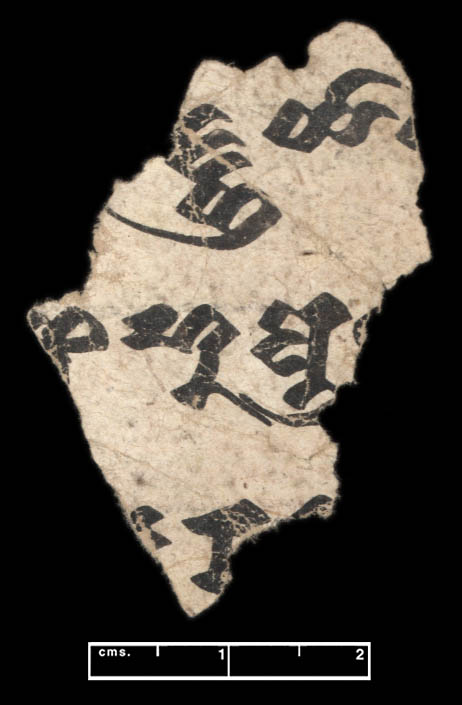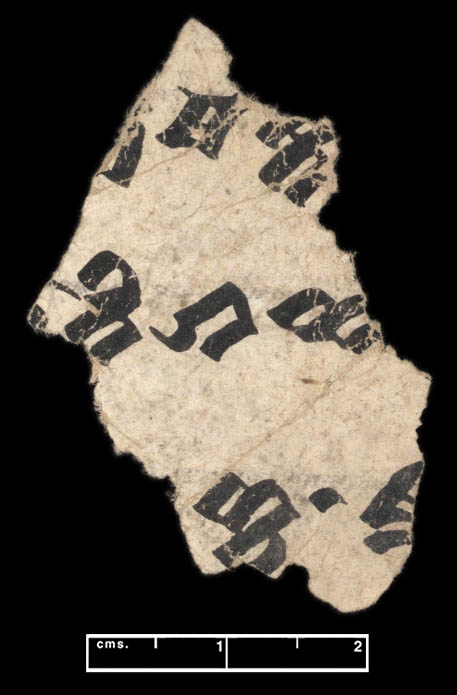IOL Toch 122 JOIN
| Known as: | IOL Toch 122 JOIN; H 149.331; IOL Toch 122; U 10.; IOL Toch 772; Tb 076 |
|---|---|
| Cite this page as: | Michaël Peyrot. "IOL Toch 122 JOIN". In A Comprehensive Edition of Tocharian Manuscripts (CEToM). Created and maintained by Melanie Malzahn, Martin Braun, Hannes A. Fellner, and Bernhard Koller. https://cetom.univie.ac.at/?m-ioltoch122_join (accessed 16 Jul. 2025). |
Edition | |
| Editor: | Michaël Peyrot |
Provenience | |
| Main find spot: | Unknown |
| Collection: | British Library (London) |
Language and Script | |
| Language: | Skt.; TB |
| Linguistic stage: | classical |
| Script: | classical |
Text contents | |
| Title of the work: | Udānavarga |
| Passage: | 12.8b-12.13b |
| Text genre: | Literary |
| Text subgenre: | Doctrine |
| Verse/Prose: | prose |
Object | |
| Material: | ink on paper |
| Form: | Poṭhī |
| Size (h × w): | 4.2 × 2.9 cm |
Images
Images from idp.bl.uk by courtesy of the International Dunhuang Project and the British Library.
Transliteration
| a1 | /// jña yā – /// /// n[i] rvi dya te – /// |
|---|---|
| a2 | /// ś·· 8 ā – /// /// – sa ye sa ññi ssa ytā /// |
| a3 | /// – ra – /// /// – s̝s̝a lle • ā khyā tā r[a] /// |
| a4 | /// ṣ·ā [ś]a lya ni kṛ nda na /// |
| a5 | /// – (– –) – /// |
| b2 | /// – : s· e mpr· tsa se s̝pa /// |
| b3 | /// ·[y]· ma kt· /// /// gā cchā kya mu ni ḥ sa [m]· /// |
| b4 | /// ·[ā] ti ga ṇ· /// /// – nne ṣe kṣe ka 10 2 [e] /// |
| b5 | /// ñca • mā /// /// – [r]i we s̝s̝aṃ se /// |
Transcription
| a1 | n1n2 /// (pra)jñayā – /// /// nirvidyate – /// |
|---|---|
| a2 | n3n4 /// °ś(cä) 8 ā(khyāto) /// /// (ākṣu)sa yesäñ ñissa ytā(rye) /// |
| a3 | n5n6 /// (ka)ra(ṇīyam) /// /// (yama)ṣṣälle • ākhyātāra(s) /// |
| a4 | n7 /// (tṛ)ṣ(ṇ)āśalyanikṛndana(ḥ) /// |
| a5 | /// – – – – /// |
| b2 | n8 /// – : s(e) empr(eṃ)tsa se ṣpä /// |
| b3 | n9n10 /// (ytār)y(e) mäkt(e) /// /// (adhya)gāc chākyamuniḥ sam(āhitaḥ) /// |
| b4 | n11n12 /// (cākhy)āti gaṇ(eṣv) /// /// (kraupe)nne ṣek-ṣekä 10-2 e(kāyanaṃ) /// |
| b5 | n13n14 /// (lkāṣṣe)ñca • mā(rgaṃ) /// /// (ytā)ri weṣṣäṃ se /// |
Translation
| a1 | [SKT] (if one recognises [that]) through wisdom /// /// [SKT] (then) he turns away (from sorrow) |
|---|---|
| a2 | [TB] (this is the way) to (complete purity) [SKT] (I have) taught (you the way) /// /// [TB] I have taught you the way |
| a3 | [SKT] ([this] is) to be done (by you;) /// /// [TB] ([this] is) to be done (by you;) [SKT] (Tathāgatas) teach [it] |
| a4 | [SKT] it destroys the thorn of craving |
| a5 | ... |
| b2 | [TB] it is straight, and it is ([the way of] exertion) |
| b3 | [TB] like (the only certain) way (of flamingos to the pond) /// /// [SKT] (which) Śākyamuni attained concentrated |
| b4 | [SKT] and (which) he teaches (constantly) in the assemblies /// /// [TB] (and which he teaches) constantly in the assemblies [SKT] (seeing the end of rebirth and old age) [he proclaims] the only certain [way] |
| b5 | [TB] seeing (the end of rebirth and old age [he proclaims] the only certain [way]) [SKT] (he proclaims) the [only certain] way, (kind and compassionate) /// /// [TB] he proclaims the [only certain] way, (kind and compassionate) |
Commentary
Parallel texts
| Bernhard 1965: 194-196; Chakravarti 1930: 143-146; Hahn 2007: 47-48 |
Philological commentary
| The size of the lacuna between the left hand fragment IOL Toch 772 and the right hand fragment IOL Toch 122 may be estimated between 7 and 14 akṣaras on the basis of the following speculative restorations (for several correspondences there are more possibilities, which are not noted here): | |
| The difference between 7 akṣ. for lines a3/b3 and 10-14 akṣ. for lines a1-2/b4-5 suggests that a3/b3 contained the string hole space. On the basis of IOL Toch 122 b2, which preserves 7 full akṣaras on 6,4 cms, the size of a lacuna of 11-12 akṣaras may have been approximately 10 cms. | |
| n1 | Uv.12.8b-c prajñayā paśyate yadā | atha nirvidyate duḥkhād |
| n2 | (pra)jñayā (paśyate yadā aiśamñesa lkāṣṣäṃ krui atha) nirvidyate = 14 akṣ. |
| n3 | Uv.12.8d-9a eṣa mārgo viśuddhaye // 8 ākhyāto vo mayā mārgaḥ |
| n4 | ā(khyāto vo mayā mārgaḥ ākṣu)sa = 10 akṣ. |
| n5 | Uv.12.9c-d yuṣmābhir eva karaṇīyam ākhyātāras tathāgatāḥ |
| n6 | (ka)ra(ṇīyam yessa yama)ṣṣälle = 7 akṣ. |
| n7 | Uv.12.10b tṛṣṇāśalyanikṛntanaḥ; all manuscripts used by Bernhard 1965: 195, including this one, read °nikṛndana° |
| n8 | Uv.12.12a eṣo ’ñjaso hy eṣa ca vai parākramas |
| n9 | Uv.12.12b-c tv ekāyano haṃsapatho yathā hrade | yam adhyagāc chākyamuniḥ samāhitas |
| n10 | mäkt(e yolmeścä • yam adhya)gāc = 7 akṣ. |
| n11 | Uv.12.12d-13a tam eva cākhyāti gaṇeṣv abhīkṣṇaśaḥ || 12 ekāyanaṃ jātijarāntadarśī |
| n12 | gaṇ(eṣv abhīkṣṇaśaḥ tāu ṣpä aksaṣṣäṃ kraupe)nne = 12 akṣ. |
| n13 | Uv.12.13a-b ekāyanaṃ jātijarāntadarśī mārgaṃ vadaty eṣa hitānukampī |
| n14 | mā(rgaṃ vadaty eṣa hitānukampī ytā)ri = 11 akṣ. |
Remarks
| This fragment (IOL Toch 122, right) is from the same leaf as IOL Toch 772, left: IOL Toch 772 a1-3 and IOL Toch 772 b3-5 precede IOL Toch 122 a1-3 and IOL Toch 122 b3-5 by approximately 7 to 14 akṣ. or 10 cms (see the philological commentary for details). Traces of lines a5 and b1, which contained Uv.12.10c-11d, can be discerned. If the string hole space covered only a3/b3, the manuscript must originally have had 5 lines. |
References
Online access
IDP: IOL Toch 122, IOL Toch 772
Edition
Sieg and Siegling 1932: 495-496; Lévi 1933: 46; Thomas 1971: 21-22; Peyrot 2007: №122; Peyrot 2008a: 100
Translations
Hackstein 1995: a2 (332)
Bibliography
Bernhard, Franz. 1965. Udānavarga. Band I, Einleitung, Beschreibung der Handschriften, Textausgabe, Bibliographie. Sanskrittexte aus den Turfanfunden 10. Göttingen: Vandenhoeck und Ruprecht.
Chakravarti, Niranjan Prasad. 1930. L‘Udānavarga sanskrit, Texte sanscrit en transcription, avec traduction et annotations, suivi d‘une étude critique et de planches. Tome premier (Chapitres I à XXI). Paris: Geuthner.
Hackstein, Olav. 1995. Untersuchungen zu den sigmatischen Präsensstammbildungen des Tocharischen. HS Erg.-Heft 38. Göttingen: Vandenhoeck & Ruprecht.
Hahn, Michael. 2007. Vom rechten Leben, Buddhistische Lehren aus Indien und Tibet, Aus dem Sanskrit und aus dem Tibetischen übersetzt und herausgegeben. Frankfurt am Main/Leipzig: Verlag der Weltreligionen (im Insel Verlag).
“The International Dunhuang Project: The Silk Road Online.” n.d. http://idp.bl.uk.
Lévi, Sylvain. 1933. Fragments de textes koutchéens. Udānavarga, Udānastotra, Udānālaṁkāra et Karmavibhaṅga, publiés et traduits avec un vocabulaire et une introduction sur le «tokharien». Paris: Imprimerie Nationale.
Peyrot, Michaël. 2007. “An edition of the Tocharian fragments IOL Toch 1 – IOL Toch 822 in the India Office Library.” International Dunhuang Project. 2007. http://idp.bl.uk/database/oo_cat.a4d?shortref=Peyrot_2007.
Peyrot, Michaël. 2008a. “More Sanskrit – Tocharian B bilingual Udānavarga fragments.” Indogermanische Forschungen 113: 83–125.
Sieg, Emil, and Wilhelm Siegling. 1932. “Udānavarga-Uebersetzungen in ‘Kucischer Sprache,’ 1930-32.” Bulletin of the School of Oriental and African Studies 6: 483–99.
Thomas, Werner. 1971. Bilinguale Udānavarga-Texte der Sammlung Hoernle. Abhandlungen d. Geistes- und Sozialwissenschaftlichen Klasse 7. Mainz: Verlag d. Akad. d. Wissenschaften und d. Literatur.






